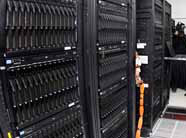
The University of Valencia has increased tenfold, without any cost, the renderings of the supercomputer Tirant, node of the Spanish Supercomputing Network. This improvement has been achieved as a result of the transferring from Barcelona to the Centre de Procés de Dades (CPD) (Data Processing Centre) of Burjassot of some fourteen tones of computer equipment, which were part of Mare Nostrum, the central node of which depended Tirant.
Thus, researchers of the University (and other centres of the Valencian Country) will have a range of resources in supercomputing 10 times higher than the current one.
The operation has been developed over three weeks. The transfer of equipment from Barcelona has allowed replacing some elements and adding new ones, so Tirant is now composed of 512 blades with 2 processors PowerPC 970MP dual core at 2,2GHz and 4 GB of RAM interconnected by a Myrinet network. This configuration provides to Tirant 2.048 cores (before 512), of which 2.016 are exclusively dedicated to the execution of works. This configuration has a theoretical maximum performance of 18.8 Tflops.
The storage, based on the filesystem General Parallel FileSystem (GPFS) of IBM, has also been expanded. Specifically the University has grown from 11,2 TB ( 4 Trays of disks) to 44,9 TB (divided into 8 trays of disks), so the space resultant is configured for backups.
According to the agreement with BSC, the contingent assigned to the University of Valencia (UV) goes from 20% to 50%. The increase of contingent plus the increased power allows a tenfold increase of the range of resources in supercomputing for the researchers of the University and other Valencian centres.
The origin of this power extension and storage capacity dates back to 2007, when was created the Spanish Supercomputing Network (RES), formed by the Barcelona Supercomputing Centre- National Supercomputing Centre (BSC-CNS), which acts as a coordinator node, the Technical University of Madrid, the University of Cantabria, the Institute of Astrophysics of Canary Islands, the University of Malaga, the University of Valencia, the University of Zaragoza and the Technological Institute of the Canary Islands.
Partnership agreement
The initial partnership agreement between these institutions anticipated the creation of a network node in each of the centres with the computer equipment that the central node (Mare Nostrum) replaced during its updates. Thus, the investment realized in equipment is most profitable, because the renewed systems are accessible again for researchers. The updating of Mare Nostrum in 2006 led to the installation at the end of 2007 of the node of Valencia, named Tirant, with a total of 512 processors and 4,5 Tflops of theoretical maximum performance.
It was in October 2012 when starts again the updating of Mare Nostrum, so under the agreement of RES, there was a new transfer of equipment between BSC-CNS and the nodes.
Last update: 14 de january de 2013 12:34.
News release



















